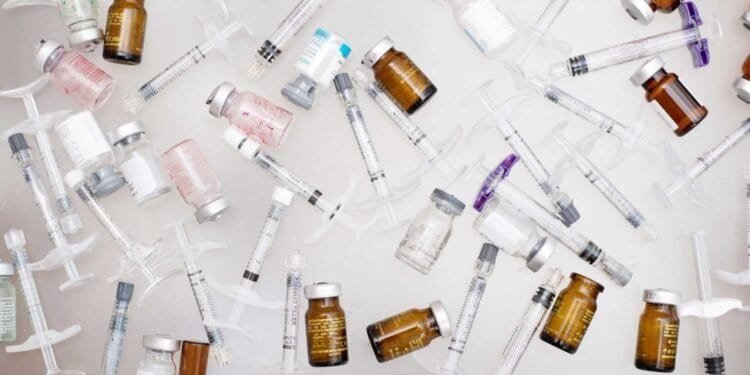Innovative therapies are emerging in the treatment of Chronic Inflammatory Response Syndrome (CIRS), a complex illness caused by exposure to biotoxins such as mold. CIRS is a multisystem, multi-symptom illness that can be difficult to diagnose and treat. However, recent advancements in CIRS research have led to the development of new and promising treatment strategies.

Understanding CIRS is key to developing effective treatment strategies. CIRS is a condition in which the body’s immune system becomes dysregulated in response to biotoxin exposure, leading to chronic inflammation and a range of symptoms affecting multiple systems in the body. Symptoms of CIRS can include fatigue, brain fog, joint pain, gastrointestinal problems, and respiratory issues, among others. However, because the symptoms of CIRS can be similar to those of other conditions, diagnosis and assessment can be challenging.
Key Takeaways
- CIRS is a complex illness caused by exposure to biotoxins such as mold.
- Recent advancements in CIRS research have led to the development of new and promising treatment strategies.
- Treatment for CIRS requires an individualized, multi-faceted approach aimed at removing mold and biotoxins from the body, quieting inflammation, and assisting the body with cellular and tissue repair.
Understanding CIRS
Chronic Inflammatory Response Syndrome (CIRS) is a complex and multifaceted condition that can result from exposure to biotoxins such as mold, Lyme disease, and other environmental toxins. CIRS can be difficult to diagnose and treat, and it can lead to a wide range of symptoms that can be debilitating for patients.
Pathophysiology of CIRS
CIRS is characterized by a dysregulated immune response to biotoxins, resulting in chronic inflammation and a range of symptoms. Biotoxins can activate the immune system, leading to the release of inflammatory cytokines and other immune mediators. This can result in a cascade of inflammatory events that can damage tissues and organs throughout the body.
Identifying CIRS Markers
There are a number of markers that can be used to identify CIRS, including elevated levels of inflammatory cytokines, decreased levels of regulatory T cells, and increased levels of complement activation products such as C3a and C4a. These markers can be used to help diagnose CIRS and to monitor the effectiveness of treatment.
Genetic Factors in Susceptibility
Genetic factors can also play a role in susceptibility to CIRS. Certain genetic variants can make individuals more susceptible to the effects of biotoxins, and can also affect the way that the immune system responds to these toxins. Understanding the genetic factors that contribute to CIRS can help to identify individuals who may be at higher risk, and can also help to guide treatment strategies.
In summary, CIRS is a complex condition that can result from exposure to biotoxins, leading to chronic inflammation and a range of symptoms. By understanding the pathophysiology of CIRS, identifying CIRS markers, and considering genetic factors in susceptibility, it is possible to develop effective treatment strategies for patients with this condition.
Diagnosis and Assessment
When it comes to diagnosing Chronic Inflammatory Response Syndrome (CIRS), there are several factors that healthcare providers must consider. These include the patient’s symptoms, medical history, and environmental exposure. In this section, we will explore the various diagnostic criteria, biomarkers, and laboratory tests that are used to assess CIRS.
Clinical Diagnostic Criteria
The clinical diagnostic criteria for CIRS were first established by Dr. Ritchie Shoemaker, a pioneer in the field of biotoxin illness. According to Dr. Shoemaker’s criteria, a patient must meet the following criteria to be diagnosed with CIRS:
- A history of exposure to water-damaged buildings (WDB) or biotoxins
- A genetic predisposition to biotoxin illness
- Symptoms consistent with biotoxin illness
- Visual Contrast Sensitivity (VCS) score of < 1.5
Biomarkers and Laboratory Tests
In addition to the clinical diagnostic criteria, there are several biomarkers and laboratory tests that can be used to assess CIRS. These include:
- HLA-DR genetic testing: This test can determine if a patient has a genetic predisposition to biotoxin illness.
- C4a and TGF-beta 1: These biomarkers are often elevated in patients with CIRS.
- MMP-9: This biomarker is often elevated in patients with mold exposure.
- VCS testing: This test measures a patient’s ability to distinguish between different shades of gray. A low score can be an indication of biotoxin illness.
Environmental and Exposure History
Another important aspect of diagnosing CIRS is taking a thorough environmental and exposure history. This includes asking the patient about any history of exposure to water-damaged buildings, mold, or other biotoxins. It is also important to ask about any symptoms that may be related to biotoxin exposure, such as fatigue, brain fog, or joint pain.
In conclusion, diagnosing CIRS requires a comprehensive approach that takes into account the patient’s symptoms, medical history, and environmental exposure. By using a combination of clinical diagnostic criteria, biomarkers, laboratory tests, and environmental and exposure history, healthcare providers can accurately diagnose and assess CIRS in their patients.
Sources and Triggers of CIRS
CIRS is a complex condition that can be triggered by a variety of sources, including mold exposure, water-damaged buildings, toxins, infections, and biotoxin illness. In this section, we will discuss the two most common sources and triggers of CIRS: mold and biotoxin illness.
Mold and Water-Damaged Buildings
Mold is a common trigger of CIRS. When mold spores are inhaled, they can cause a range of symptoms, including fatigue, brain fog, joint pain, and respiratory problems. Mold exposure can occur in a variety of settings, including homes, schools, and workplaces. Water-damaged buildings are particularly prone to mold growth, as the damp conditions provide an ideal environment for mold to thrive.
In water-damaged buildings, mold can grow on a variety of surfaces, including walls, ceilings, and floors. It can also grow in hidden areas, such as behind walls and under carpeting. If left untreated, mold can spread throughout a building and cause significant damage to the structure.
To prevent mold growth in water-damaged buildings, it is important to address the underlying moisture problem. This may involve repairing leaks, improving ventilation, and removing water-damaged materials. It is also important to clean up any visible mold using appropriate cleaning products and personal protective equipment.
Biotoxin Illness and Infections
Biotoxin illness is another common trigger of CIRS. Biotoxins are toxins produced by certain types of organisms, including mold, bacteria, and algae. When these toxins enter the body, they can cause a range of symptoms, including fatigue, brain fog, joint pain, and respiratory problems.
Infections can also trigger CIRS. When the body is infected with a pathogen, such as a virus or bacteria, it mounts an immune response to fight off the infection. In some cases, this immune response can become dysregulated and lead to chronic inflammation and other symptoms associated with CIRS.
To prevent biotoxin illness and infections, it is important to take steps to reduce exposure to these triggers. This may involve avoiding water-damaged buildings, using appropriate personal protective equipment when working in potentially contaminated environments, and practicing good hygiene to reduce the risk of infection.
In conclusion, mold exposure and biotoxin illness are two common sources and triggers of CIRS. By taking steps to reduce exposure to these triggers, individuals can help prevent the development of this complex condition.
Symptomatology of CIRS

Chronic Inflammatory Response Syndrome (CIRS) is a complex condition that can affect multiple systems in the body. The symptoms of CIRS can vary from person to person and may include a combination of neurological, respiratory, and systemic symptoms.
Neurological and Cognitive Impacts
One of the most common symptoms of CIRS is neurological and cognitive impairment. Patients with CIRS often report experiencing brain fog, difficulty concentrating, and memory problems. They may also experience headaches, dizziness, and balance issues. In some cases, patients may develop depression or anxiety.
Respiratory and Systemic Symptoms
CIRS can also cause respiratory and systemic symptoms. Patients may experience shortness of breath, cough, and wheezing. They may also develop fatigue, joint pain, and muscle weakness. Additionally, patients with CIRS may experience gastrointestinal symptoms such as abdominal pain, diarrhea, and bloating.
It is important to note that the symptoms of CIRS can be similar to those of other conditions, including Lyme disease, fibromyalgia, and chronic fatigue syndrome. Therefore, it is important for patients to receive a thorough evaluation and diagnosis from a qualified healthcare provider.
Innovative therapies are being developed to treat CIRS, and early intervention may help prevent long-term complications. Treatment options may include detoxification protocols, nutritional support, and anti-inflammatory medications. Patients may also benefit from cognitive-behavioral therapy or other forms of psychological support to help manage the emotional impact of the condition.
Overall, a multidisciplinary approach to treatment is recommended for patients with CIRS, and ongoing monitoring is necessary to ensure that symptoms are effectively managed.
Treatment Strategies for CIRS

CIRS is a complex and challenging condition to treat, and there is no one-size-fits-all approach. Treatment strategies for CIRS typically involve a combination of pharmacological interventions, detoxification and environmental control, and holistic and supportive therapies.
Pharmacological Interventions
Pharmacological interventions play an essential role in the treatment of CIRS. Cholestyramine is one of the most commonly used medications for CIRS. It is a bile acid sequestrant that binds to bile acids in the gut and prevents their reabsorption. This helps to eliminate toxins from the body and reduce the toxic burden on the liver. Other binders, such as activated charcoal and bentonite clay, may also be used to eliminate toxins from the body.
Detoxification and Environmental Control
Detoxification support is crucial in the treatment of CIRS. This involves removing toxins from the body and creating a clean and healthy environment. Detoxification can be achieved through a variety of methods, including sauna therapy, colon hydrotherapy, and liver support. Environmental control involves identifying and removing sources of toxins in the patient’s environment, such as mold, chemicals, and other toxins.
Holistic and Supportive Therapies
Holistic and supportive therapies can also play an essential role in the treatment of CIRS. Probiotics can help to restore gut health and improve the immune system. Yoga and other mind-body therapies can help to reduce stress and promote relaxation. Other supportive therapies, such as acupuncture, massage, and nutritional counseling, may also be beneficial in the treatment of CIRS.
In conclusion, the treatment of CIRS requires a comprehensive and individualized approach. By combining pharmacological interventions, detoxification and environmental control, and holistic and supportive therapies, patients can achieve significant improvements in their symptoms and overall health.
The Role of Diet and Lifestyle

Diet and lifestyle modifications can play an important role in the management of Chronic Inflammatory Response Syndrome (CIRS). Nutritional support and stress management techniques are two key areas that can be addressed.
Nutritional Support
A well-balanced diet that includes nutrient-dense foods can help support the body’s natural detoxification processes. Adequate protein intake is important for the production of glutathione, a powerful antioxidant that helps remove toxins from the body. Foods that are rich in sulfur, such as garlic and onions, can also support glutathione production.
In addition, gut health is an important consideration in CIRS management. A healthy gut microbiome can help support the immune system and reduce inflammation. Probiotic-rich foods such as yogurt and kefir, as well as prebiotic foods such as asparagus and bananas, can help promote a healthy gut.
Stress Management and Mind-Body Practices
Stress and anxiety can exacerbate inflammation and worsen CIRS symptoms. Stress management techniques such as meditation, yoga, and deep breathing exercises can help reduce stress and promote relaxation.
In addition, sauna therapy has been shown to be effective in reducing inflammation and supporting detoxification. Sauna use can increase circulation, promote sweating, and help remove toxins from the body.
Overall, incorporating these diet and lifestyle modifications can help support the body’s natural detoxification processes and reduce inflammation in individuals with CIRS.
Advancements in CIRS Research
Emerging Therapies
In recent years, there have been significant advancements in the treatment of CIRS. One of the most promising areas of research has been in the field of functional medicine. This approach to medicine focuses on identifying and addressing the root causes of disease, rather than simply treating symptoms. Functional medicine practitioners have been successful in treating CIRS by addressing underlying issues such as gut dysbiosis, mitochondrial dysfunction, and chronic infections.
Another area of emerging research in the treatment of CIRS is the role of transforming growth factor beta (TGF-β). This cytokine has been found to play a key role in the development of CIRS, and researchers are currently exploring ways to modulate its activity. Some promising therapies include the use of TGF-β inhibitors and the use of agents that promote TGF-β signaling.
Vascular endothelial growth factor (VEGF) is another area of interest in CIRS research. This cytokine is involved in the regulation of angiogenesis and has been found to be dysregulated in patients with CIRS. Researchers are currently exploring the use of VEGF inhibitors as a potential therapy for CIRS.
Future Directions in CIRS Treatment
Looking to the future, there are several exciting areas of research in the treatment of CIRS. One promising area is the use of stem cell therapy. Stem cells have the potential to regenerate damaged tissue and modulate the immune system, which could be beneficial in the treatment of CIRS.
Another area of interest is the use of gene therapy. Researchers are exploring ways to use gene editing techniques to correct genetic mutations that may contribute to the development of CIRS.
Finally, there is growing interest in the use of personalized medicine in the treatment of CIRS. This approach involves tailoring treatment to the individual patient based on their unique genetic, environmental, and lifestyle factors. By taking a personalized approach, practitioners may be able to achieve better outcomes for patients with CIRS.
Overall, the field of CIRS research is rapidly evolving, and there is much to be optimistic about in terms of the development of innovative therapies. With continued research and development, it is likely that we will see significant improvements in the treatment of this complex condition in the years to come.
Patient Resources and Support
Living with Chronic Inflammatory Response Syndrome (CIRS) can be overwhelming, and patients need a strong support system to help them navigate their journey towards recovery. Fortunately, there are a variety of educational materials, support groups, and advocacy organizations available to help patients and their families.
Educational Materials
Patients and their families can benefit from educational materials that provide accurate and up-to-date information about CIRS and related conditions. These materials can help patients better understand their condition, its causes, and the potential treatments available.
There are a number of resources available online, including websites, blogs, and forums, that provide information about mold illness, chronic inflammation, and related conditions. Patients should be cautious when seeking information online and should only rely on reputable sources.
Support Groups and Advocacy
Support groups can be a valuable resource for patients and their families. These groups provide a safe and supportive environment where patients can share their experiences, ask questions, and receive emotional support.
There are a number of support groups available for patients with CIRS, including online groups and in-person meetings. Patients can also benefit from advocacy organizations that work to raise awareness about CIRS and related conditions, and that advocate for better access to treatment and care.
Overall, patients with CIRS can benefit from a strong support system that includes educational materials, support groups, and advocacy organizations. By working together, patients and their families can better understand their condition and navigate the challenges of living with CIRS.
Frequently Asked Questions
What are the key components of the Shoemaker Protocol for treating CIRS?
The Shoemaker Protocol is a multi-step process that involves identifying and removing the source of biotoxin exposure, detoxifying the body, and supporting the body’s natural healing processes. Key components of the protocol include testing for biotoxin exposure, using binders to remove toxins from the body, addressing any underlying infections, and supporting the body with supplements and lifestyle changes.
Is it possible to achieve full recovery from CIRS with current therapies?
While there is no cure for CIRS, it is possible to achieve significant improvement in symptoms and quality of life with current therapies. The key is to identify and remove the source of biotoxin exposure, detoxify the body, and support the body’s natural healing processes. Recovery times vary depending on the severity of the condition and individual factors such as genetics and lifestyle.
How does diet influence the management and treatment of CIRS?
Diet plays a crucial role in the management and treatment of CIRS. A nutrient-dense, anti-inflammatory diet can help support the body’s natural healing processes and reduce inflammation. Key components of a CIRS-friendly diet include avoiding inflammatory foods such as sugar, processed foods, and alcohol, and focusing on whole, nutrient-dense foods such as vegetables, fruits, healthy fats, and lean proteins.
What are the recommended lab tests for diagnosing and monitoring CIRS?
The recommended lab tests for diagnosing and monitoring CIRS include testing for biotoxin exposure, evaluating immune function, assessing inflammation levels, and monitoring organ function. Specific tests may include urine mycotoxin testing, C4a and TGF-beta 1 testing, and liver function tests.
What criteria should be used to select a doctor specialized in the treatment of CIRS?
When selecting a doctor specialized in the treatment of CIRS, it is important to look for someone who has experience and expertise in treating the condition. Look for a doctor who is familiar with the Shoemaker Protocol and other cutting-edge treatments for CIRS. It may also be helpful to seek out a doctor who takes a holistic approach to health and wellness.
What are the latest advancements in the treatment of CIRS?
The latest advancements in the treatment of CIRS include the use of cutting-edge therapies such as ozone therapy, hyperbaric oxygen therapy, and stem cell therapy. These therapies can help support the body’s natural healing processes and reduce inflammation. It is important to work with a qualified healthcare provider to determine which therapies are right for you.














